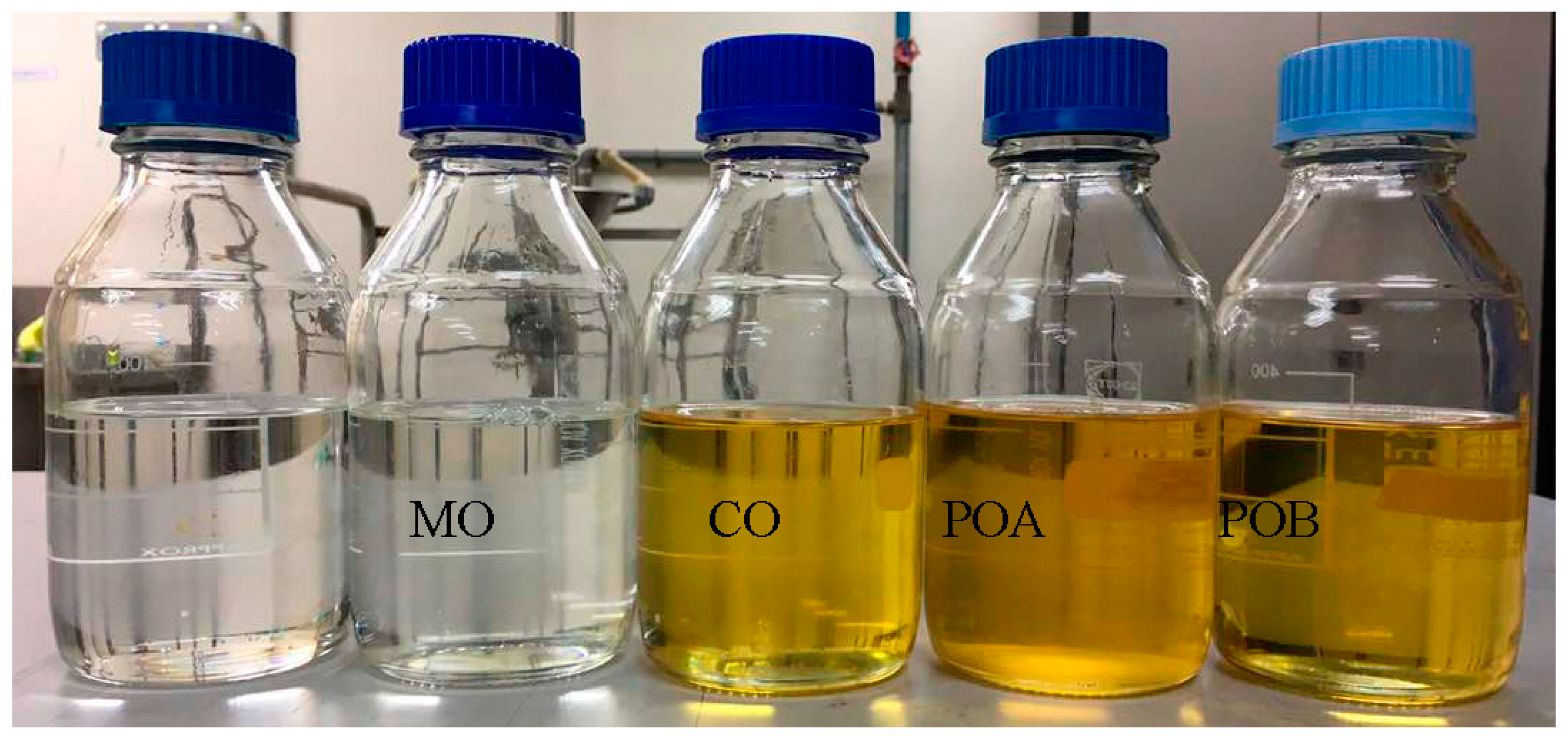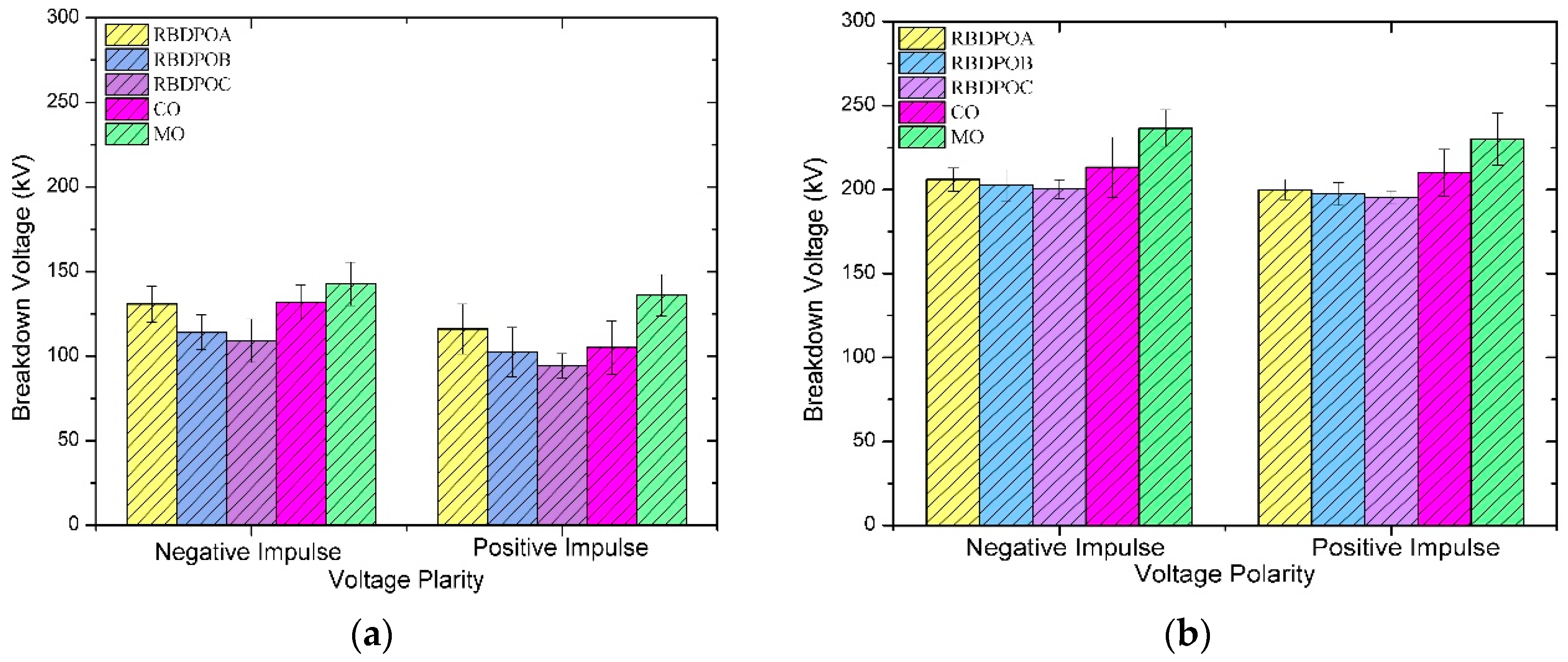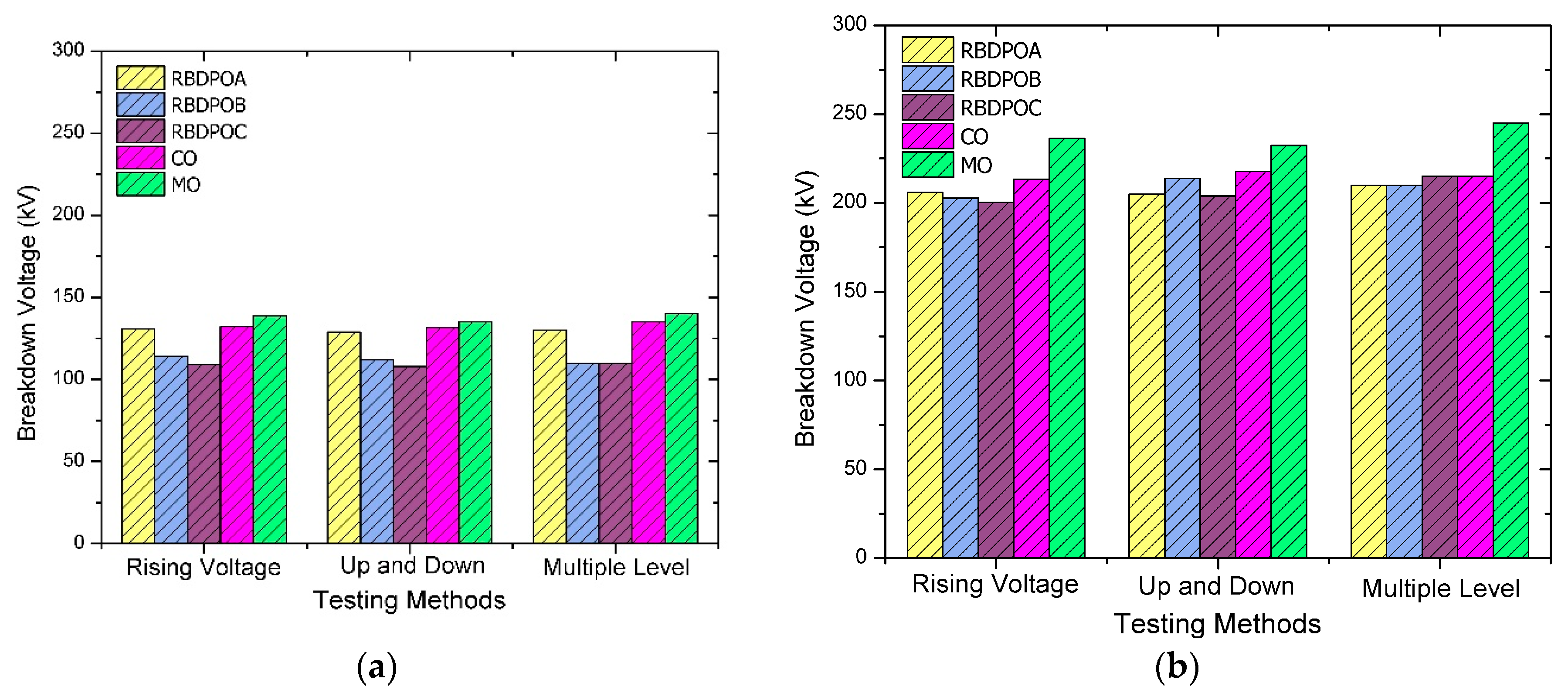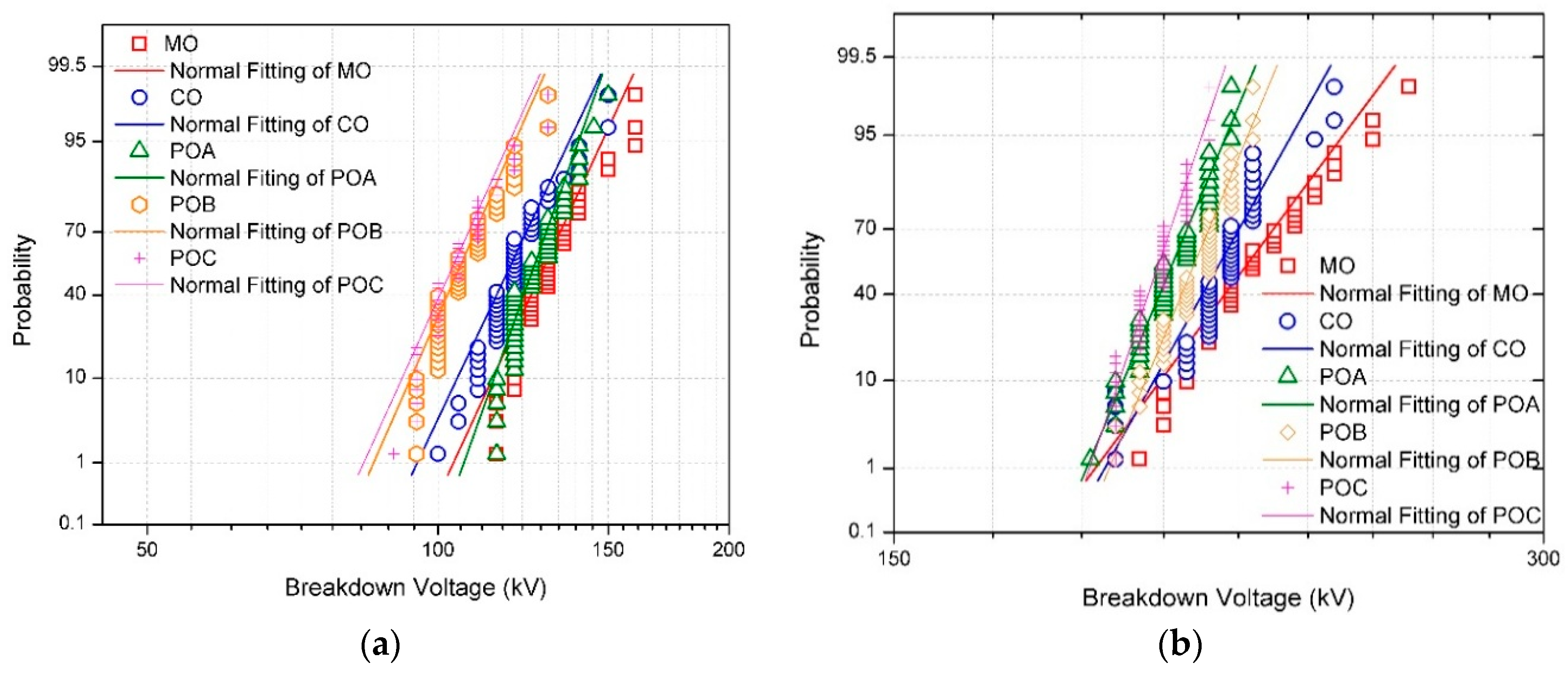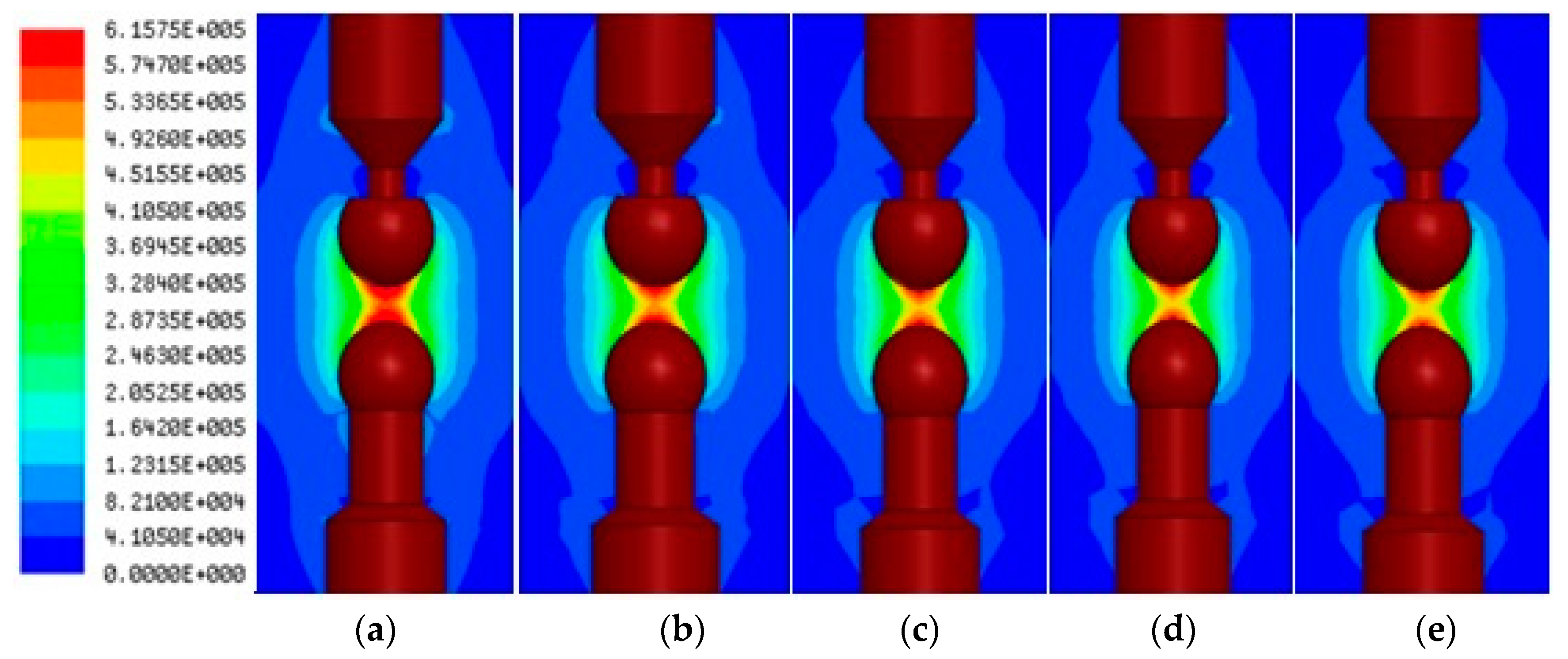1. Introduction
Application of vegetable oils in power transformers has been investigated intensively in the past few decades [
1,
2,
3,
4,
5,
6,
7,
8]. Vegetable oils have been considered due to their better environmental performance and safety aspects, i.e., when decomposed, they produce almost no toxic products thus no pollution is created. Currently, vegetable oils produced from palm oil (PO) and coconut oil (CO) are being considered as dielectric liquids in transformers. Both these oils are biodegradable and non-toxic, which makes them desirable for transformer applications. A number of studies had been carried out on PO and CO covering different aspects such as their dielectric, chemical and physical properties and ageing characteristics [
8,
9,
10,
11,
12,
13,
14]. It was found that their physical and chemical properties are closely similar to those of natural esters which have been widely used in transformers. In general, there are different types of PO that can be obtained from palm nuts. These are Crude Palm Oil (CPO), Palm Kernel Oil (PKO) and Refined, Bleached and Deodorized Palm Oil (RBDPO). CPO can be extracted from the mesocarp, while PKO can be extracted from the palm nut kernels. Further refining of CPO produces RBDPO. Then, RBDPO Olein is produced through a fractionation of RBDPO. On the other hand, PKO can be further reacted to become PKO Alkyl Ester [
9,
10]. Among these oils, RBDPO is the most commonly proposed for transformer applications. This is because it has a higher breakdown voltage and equality characteristics, i.e., low loss factor and high relative permittivity compared to mineral oil [
3,
9]. CO is a colourless to pale brownish-yellow liquid extracted from the kernel of mature coconut palms. After a purification processes involving neutralization, bleaching, and deodorization the properties of CO are suitable for use as a transformer oil [
13].
Lightning impulse breakdown voltage is commonly used as the insulation design criterion for large transformers. Therefore, it is usually required as a routine factory test for transformers with a power larger than 170 kV. An essential lightning impulse breakdown test needs to be performed before PO and CO can be considered as an insulating liquid for transformers. It can be performed under uniform, quasi-uniform, and non-uniform field conditions. The uniform and quasi-uniform fields can be represented by plane-plane and sphere-sphere electrode configurations. These configurations replicate the uniform and quasi-uniform fields experienced by the majority of insulation material inside a transformer, e.g., between turns, disks, and windings. These are usually tested to represent the in-service conditions in transformers. The non-uniform field can be created using either point-plane or point-sphere configurations which represent the imperfections that could occur in transformers.
Generally, the lightning impulse breakdown voltage of ester liquids investigated is either positive or negative in polarity [
15,
16,
17,
18,
19,
20,
21,
22,
23,
24,
25]. In a non-uniform field, there is usually an obvious polarity effect that positive polarity results in a higher discharge inception voltage (but lower breakdown voltage) than negative polarity due to space charged issue. On the other hand, this event is not expected in a uniform/quasi-uniform field. This was confirmed by Liu [
15], where no polarity effect was observed for both the ester liquids or mineral oil under uniform/quasi-uniform field conditions. This phenomenon is due to the symmetrical configuration of the electrodes. Liu also found out that the average lightning breakdown voltages of the ester liquids are slightly lower than the mineral oil under both positive and negative polarities.
Hemmer [
26] performed another study by using a positive polarity lightning breakdown voltage for rape-seed oil at gap distances from 5 mm to 15 mm in a plane-plane electrode. The results indicated that the rape-seed oil has a similar breakdown voltage as mineral oil. In another study [
18], it was observed that the lightning impulse tests for a larger gap in uniform/quasi-uniform fields become more difficult. This is due to larger volume of sample and the fact longer time is required for sample preparation. In that paper, the lightning breakdown voltages of FR3 natural ester (soya-seed- based oil) in quasi-uniform fields at gap distances between 12 mm to 50 mm was reported. The volume of oil used in the experiment was in the range of 210 to 2400 litres. The lightning impulse breakdown tests were conducted using the rising-voltage method. The lightning breakdown voltages of natural esters are comparable to mineral oil with a maximum of 17% reduction at the largest gap distance under both polarities.
Besides that, various testing methods, including rising-voltage method [
26,
27,
28], up-and-down method [
29,
30] and multiple method [
29,
30] were used to test impulse strength of the vegetable oils. Thien [
31] performed a study on the lightning breakdown voltages of PO and CO under non-uniform field conditions and found that there is a slight effect of the voltage polarities on the 50% breakdown voltages of PO and CO where the negative polarity gave higher 50% breakdown voltage than positive polarity. The authors also found that the multiple-level method has the highest breakdown voltages compared with the other methods. These results might not be valid for quasi-uniform electric field. Therefore, this paper tries to investigate the effect on the impulse breakdown voltages of PO, CO and mineral oil in a quasi-uniform electric field. The influences of testing methods and voltage polarity on the 50% breakdown voltages were also investigated. In addition, withstand voltage at 1% breakdown probability of PO and CO is deduced using statistical analysis. Finally, based on statistical studies and simulation using ANSYS software version 19.1, the equations, based on the combination of experiment data and simulation for all samples, were derived.
3. Results and Analysis of Data
3.1. Polarity Effect on Breakdown Voltages
The 50% lightning breakdown voltages under positive and negative polarities of the samples are given in
Table 2 and
Table 3. From the tables, under negative polarity at 3.8 mm gap distance, the mean breakdown voltage of MO is the highest at 236.33 kV, followed by CO (217.83 kV), POA (206 kV), POB (202.67 kV) and then POC with 200.33 kV, whereas, under positive polarity at the same gap distance, the mean breakdown voltage of MO is also the highest at 230 kV followed by CO, POA, POB and POC with 210 kV, 200 kV, 197.33 kV and 195.33 kV, respectively. Based on
Table 2, under both positive and negative voltage polarities, MO has the highest breakdown voltage among all the types of oils. A cross comparison of the effect of polarities on LI breakdown voltages between PO, CO and MO is plotted in
Figure 3.
Using mineral oil as the baseline, under positive polarity, the highest percentages of difference on the 50% breakdown voltages between RBDPO and MO, are 24.7% (POC) at 2 mm gap and 15.1% (POC) at 3.8 mm gap. While CO has 3.4% (2.0 mm) and 8.7% (3.8 mm) percentages of difference in the breakdown voltages compared to mineral oil. On the other hand, under negative polarity, the highest percentage of difference on the 50% breakdown voltages between RBDPO and MO, are 22.3% (POC) at 2 mm gap and 15.2% (POC) at 3.8 mm gap, while CO has 4.8% (2.0 mm) and 7.8% (3.8 mm) percentages of difference in the breakdown voltages compared to mineral oil.
The highest percentage of differences in the 50% breakdown voltage of RBDPO between positive and negative voltage polarities at 2.0 mm and 3.8 mm gaps are 5.2 % (POB) and 3.0 % (POA) respectively, while for CO and MO, the highest differences between positive and negative polarities at 2.0 mm gap, are 3.7% and 1.2% respectively. For the 3.8 mm gap, the percentage differences between positive and negative polarities, are 2.8% and 3.7%. The percentage of difference for both polarities under difference gap distances is less than 5% for all oil samples. As seen in the results, the breakdown voltage under negative polarity is almost similar to that under positive for the same gap distance. This might be due to space charge issue in a uniform field as mentioned by Liu. Normally in a non-uniform field, there is usually an obvious polarity effect found in which the negative polarity LI breakdown voltages result in a lower discharge inception voltage but a higher breakdown voltage than positive polarity. However, such a phenomenon is not expected in a uniform field due to the symmetric configuration. The results from this study and supported by the previous work by Liu [
21], confirm that there is no polarity effect for both the vegetable oil and the mineral oil under quasi-uniform electric field.
3.2. Testing Methods Effect on the Breakdown Voltage
In this section, various testing methods were used for the lightning breakdown tests such as rising voltage, up and down and multiple level methods. Negative polarity was used in this study since the results in the negative polarity still valid for positive polarity based on the previous studies. The 50% lightning breakdown voltages of RBDPO, CO and MO are summarized in
Table 4 and the cross-comparison of impulse breakdown voltages between the oil samples is plotted in
Figure 4.
Taking the rising voltage method as a reference, at 2.0 mm gap, it can be seen in
Table 4 that the multi-level method having the highest percentage of differences among the methods with the biggest differences can be seen in POB with 5.3%, followed by CO with 2.3%, MO with 1%, POC with 0.9% and lastly POA with 0.5%. For the up and down method, the highest percentage difference can be seen for MO with 2.5% and CO has the lowest percentage difference with 0.4%. However, as the gap distance increases, the percentage differences in all the testing methods show increases with the multiple-level method still having the highest percentage difference with 7% for POC. For the up and down method, POB has the highest percentage difference between the oils with 5.6% and CO shows no changes in the breakdown voltage, when compared to the rising-up method at 3.8 mm gap.
It can be seen that the POs have comparable 50% breakdown voltages with CO at various gap distances and testing methods where the highest percentage of difference is less than 6%, whereas, PO and CO have lower breakdown voltages compared to MO with the highest percentage of difference being less than 20% for all methods and gap distances, which is close to the previous finding [
21]. The 50% breakdown voltage of all samples for all testing methods under negative polarity is slightly higher than that under positive polarity and this agrees with the previous results. The multiple-level method always has the highest impulse breakdown voltage for all samples at both gap distances under various testing methods, followed by the rising voltage and up and down methods.
From this study, it is found that the testing methods have a notable influence on the measured breakdown voltage in which for all testing methods under both polarities and gap distances, the percentage of difference is less than 10%, in agreement with the previous study [
21]. The multi-level method has the highest percentage of difference for all cases. In addition the multi-level method and rising up method provide the closest results to each other, which generally are higher than those obtained using the up and down method. However, no matter which testing methods were used, PO and CO always showed lower breakdown voltages than MO. This might be due to streamer propagation in vegetable oils being different from in mineral oil. The previous studies in a divergent field and uniform/quasi uniform field [
15,
21,
29,
33,
34,
35] showed that the ester liquids have lower impulse breakdown voltages, especially at larger gaps, than mineral oil. This is because streamers in the vegetable oils propagate faster and further than in the mineral oil at the same voltage level. Liu [
21,
33] mentioned that the average time to breakdown for ester oils is approximated 3.8 μs compared to 5.7 μs in mineral oil. He also mentioned that, under positive polarity, the streamer velocity in vegetable oil is around 10 km/s at 50 mm of oil gap and reaches 30 km/s at 100 mm. The streamer velocity in mineral oil remains at a constant speed at 1–2 km/s under positive polarity.
From this study we can also say that all the testing methods are suitable to be used in the lightning impulse breakdown study since only a small difference in terms of breakdown voltage was found in this study. However, a rising voltage method is always the preferred method and is adopted by the IEC 60897 and ASTM D3300 standards since this method requires less time to obtain the results, the testing is easy to do and the results are consistent.
3.3. Determination of Lightning Withstands Voltage
Withstand voltage is critically important for the design of power transformer insulation. The normal distribution is usually used to fit the breakdown data, and the withstand voltage can be determined based on the fitted curve. By considering the breakdown voltages from the results obtained from different testing methods, a withstand voltage and breakdown probabilities can be determined. The normal distribution
F(
x) is given as follows:
where
μ is the mean and
σ is the standard deviation.
The breakdown voltages and the normal fitting results are shown in
Figure 5 for different gap distances and negative polarities. The estimation of withstand breakdown voltages at 1% probability and 50% probability of failure for lightning breakdown voltages of all samples can be determined using statistical analysis. A distribution is considered a good fit if the data points follow a straight line.
Between the failure rates of 10% and 90%, all the distributions give relatively similar fittings of the measurement results of the breakdown voltages for PO, CO and MO. However, at low failure rates (<10%) and high failure rates (>90%), the normal distribution gives larger prediction values than measurement results of the breakdown voltages. The findings are different for 3.8 mm gap distance where for high failure rates (>95%), the normal distribution gives lower prediction values than the measurement results of CO and MO breakdown voltages. However, at lower failure rates, the measurement results fit well with the normal distribution prediction for all oil samples except the mineral oil for which the normal distribution predicts lower values than the measured results.
Table 5 indicates the breakdown probabilities for negative polarity at 2.0 mm and 3.8 mm gap distances. The 50% breakdown voltages of PO and CO are lower than that of mineral oil, which is consistent with the conclusions previously drawn using various testing methods. Under negative polarity and at 2.0 mm gap distance, the difference on the breakdown voltages among RBDPO samples at 1% and 50% probability are between 14% and 21% as shown in
Table 5. The breakdown voltages of CO are slightly higher than POB and POC but slightly lower than POA. The difference on the breakdown voltages between CO and PO at 1% and 50%, where the highest are 12% and 13% respectively. On the other hand, the breakdown voltages of RBDPO and CO are much lower than MO where the highest percentages of differences on the breakdown voltage at 1% and 50% probabilities are 22% and 20%, respectively.
Under 3.8 mm gap distance, the difference on the breakdown voltages among RBDPO samples at 1% and 50% probability are between 2% and 5% as shown in
Table 5. The breakdown voltages of CO are slightly higher than RBDPO samples, similar to the 2.00 mm gap distance. The difference in the breakdown voltages between CO and PO at 1% and 50% where the highest percentage of difference are 2% and 7%, respectively. Similar to the previous results, the breakdown voltages of RBDPO and CO are much lower than MO where the highest percentages of differences on the breakdown voltage at 1% and 50% probability are 3% and 10% respectively.
As seen in
Table 5, the 50% breakdown voltages of vegetable oils are lower than that of mineral oil, which is consistent with previously drawn conclusions using various testing methods. Moving down to the lower breakdown probability, the difference between the vegetable oils and the mineral oil becomes smaller. The withstand voltage is always be used for the safety requirements of transformer insulation design. It also determines the amount of insulation material used in the transformer, and thus the size of the transformer. For example, if the withstand voltage of an insulating liquid is small, larger bulk oil gaps should be provided to meet the safety of a transformer. In case of POA, the withstand voltage of POA is close to mineral oil under both gap distances and the best results among the vegetable oils. Therefore the transformer designer might use a similar transformer design for using POA as insulating liquid.
3.4. Dielectric Strength Characteristics
The dielectric strength (electric field strength) is defined as the maximum stress which the insulation can withstand before breakdown. It depends on the insulation material, impurities and the geometries of the electrodes under the applied electric field. In this paper, the 2D of finite element method (FEM) model of sphere-to-sphere electrode with real geometrical dimension was developed in ANSYS Maxwell software as shown in
Figure 6. ANSYS Maxwell software is a powerful interactive environment for modeling and solving of engineering problems based on partial different equations (PDEs). The input parameters such as material, relative permittivity and conductivity of copper conductor and oils were obtained from the experiments are shown in
Table 6. All the parameters were obtained from the experiment using ADTR-2K Plus measuring equipment. The lightning injected voltage in this simulation was simulated using a double exponential curves [
36] as shown in Equation (2):
where, α = 14700,
β = 2,470,000 and
Vo is the charging voltage. In this analysis, the 50% breakdown measurements obtained from the experiments were used in the calculation and simulation of breakdown strength.
The simulated electric field distribution of 2D for the spherical electrode system is illustrated in
Figure 7. As shown in the figure, a strong electric field intensity was detected in MO and then followed by CO and PO, respectively.
For validation purposes, a simulation has been conducted using ANSYS software to simulate the dielectric field distribution. Meanwhile, the calculation was performed by using the approximate formula for a uniform field near the symmetrical axis of the same radius of the spherical electrode which valid in narrow gaps as follows [
37]:
where,
E is the maximum electric field,
V is the breakdown voltage, kV,
d is the gap distance, mm, and
R is the radius of the spherical electrodes, mm. The polar angle,
θ = 0° which corresponds to the apex of the sphere; which means that only a small part of the spherical electrode surface area near the symmetrical axis contributed to the breakdown voltage.
Table 7 shows the comparison between calculation and simulation of dielectric strength for all oil samples. It shows that very small percentage of the difference between calculation and simulated results which are between 0.1% up to 0.7%.
The simulation results match well with the calculation and experimental result at a gap distance of 3.8 mm. Hence we can use the simulation model to simulate the breakdown for larger gap distances. The simulation results for larger gap distances with similar injected voltage are shown in
Table 8.
The power law function which represents the scale effect [
21,
22] is normally used to calculate the breakdown strength
E (kV/mm) at the gap distance,
d (mm). By using the data from
Table 8, the prediction breakdown strength,
E for the oils in this study are given as follows and the equations are plotted in
Figure 8:
Figure 8 represents the relationship between lightning impulse strength and gap distance for sphere-sphere electrodes. It is noted that lightning impulse strengths for both breakdown and withstand decrease with the increase of gap distance. Similar results are also found in [
22]. This explains why liquid insulations are particularly weak when the gaps are larger, and that’s why barriers are effectively used in improving the dielectric integrity. Besides that, comparing the CO, PO, and MO, it is remarkable that the negative lightning impulse strengths of CO and PO stay close to those of MO in the quasi- uniform field at gap distance up to 25 mm in this simulation.
